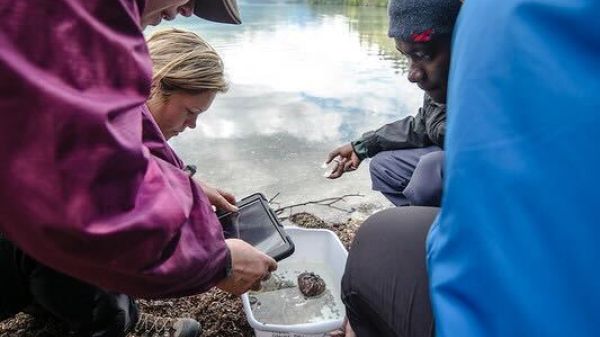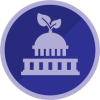eeBLUE Blog Series: Watershed Chronicles

The NOAA Office of Education and NAAEE partnered to increase environmental and science literacy among NOAA’s partners and external networks. During this five-year partnership that was supported by the U.S. Department of Education, NOAA and NAAEE worked together to provide enriching after-school watershed-related STEM (science, technology, engineering, and mathematics) projects through NOAA-21st Century Community Learning Centers Watershed STEM Education Partnership grants. These grants supported programming for a total of 100 local 21st Century Community Learning Centers (21st CCLC) sites and their students. The 30 selected projects served 18 states, ranging from Alaska to Florida.
Hear directly from the Watershed STEM Grantees as they implemented their projects, adapted to challenges, and worked collaboratively toward a blue planet. Read about their journey!
"Designed to inspire stewardship of the Galveston Bay and bring awareness to the notion that we as people are deeply connected to the planet, these student-painted murals will live on each campus for all present and future viewers to see for many years to come."
"The teachers-school-parent-museum relationships that have been built through this program will continue to serve the community for years to come."
"The students leave the school setting behind and venture into the unknown urban stream wilderness, ripe with potential meaningful watershed educational experiences (MWEEs). What these students experience will have an impact on how they look at the environment that surrounds them."
"We’ve started to become a part of the culture of the school. It’s become about more than making sure they have a deep understanding of the watershed. It’s about building their experiences and connections, opening the door to become stewards of their place."
"With a newfound sense of concern for the impacts of runoff pollution, students expressed that they wanted to make a positive impact by educating younger students in the 21C program, and to draw new interest toward watershed stewardship in a fun and positive way."
"A signature activity for Champions of Coastal resilience (CCR) is for students to find the high tide line and hold up our one-meter CCR cloth for a visual reference on potential sea-level rise by 2100. Students made observations, wondered, and discussed possible impacts and solutions for mitigation—coastal resilience analysis came to life!"
"Like the innovative and resilient network of environmental educators at NAAEE, the Stroud Center prides itself on perceiving obstacles as opportunities for innovative problem-solving. What follows are some of our richest lessons learned through watershed STEM education throughout two years (and counting!) of a pandemic."
"We spent most of our time outdoors on school grounds and on field trips to do fieldwork along a river, pond, and Long Island Sound. I thought our hands-on approach to seeing and experiencing the flow of water within a watershed really reinforced our messages of one environment and of 'What goes on the ground goes in the Sound.'"
"Creating a connection between the land and water is integral to forming a stewardship ethic from a young age, so it was important to us to create a series of activities that allowed students to see that even if they don’t live directly on a Great Lake, they are part of the Great Lakes watershed and have an effect on the overall health of the system."
"By summer we were running week-long outdoors-only summer day camps at our 15-acre nature center, a local river park, and a nearby lake. These programs also went well, but what we really want to share is the new trail we serendipitously blazed for family learning."
"During these moments, our friends remained supportive, encouraging, and even provided some comic relief as we persevered. Our youth and our community remained everyone’s focus and motivation and we were still able to spend a lot of time outdoors making friends, building community, and making lasting, positive connections to the Flint River and our waterways."
"Kids were excited to learn about and then protect their local aquatic resources. They recognized that they could have a voice in something as essential as the health of their drinking water."
"What we do know is that Puget Sound Estuarium will be there for these students in 2021–2022, in whatever capacity possible, to continue to offer STEM educational experiences about the estuarine environment of the South Sound."
"When confined by challenge, creativity can blossom. By spring, many of us had adjusted well to these new boundaries. Like salmon to saltwater, we had become anadromous naturalists, flourishing in our new habitat."
"'The Watersheds & Wildlife program encourages students to be more caring about their environment and help them gain a greater knowledge of the main purpose of the watershed,' noted a participating teacher when asked about students' engagement in the program. 'And that is one way we know our perseverance paid off,' says Johnson."
"As environmental educators, we teach about the adaptations of plants and animals and the changes found in succession and metamorphosis. This year, 'change' and 'adapt' took on new meaning for all of us."
"We know that with even a short time together at our local waterway, we can show the students how they can safely explore and make countless discoveries by connecting them with their watershed."
"It allows us to pick and choose the best parts of digital and distance learning to gain traction. If we stuck to the traditional method of delivery, that sample size of an audience would always be small."
"Seventh grade English teacher Charmaine Williams reflected, '…I really enjoyed the session on Saturday. I came with no expectation but left energized and [with] strategies to implement with my kids.'"
"The place-based curriculum is especially exciting because it strives to bring together different pieces of knowledge, experiences, and perspectives of the watershed by including guest presenters and educators from local communities, tribes, conversation organizations, harvest groups, and scientific research."
"As part of the Kāneʻohe Bay estuarine system, Waikalua provided students the opportunity to explore a transitional ecosystem and contribute to the restoration of this ancient aquaculture facility."
"Looking ahead this Fall, I know we will have more challenges that will require more creative thinking and flexibility, but this first experience building relationships, setting the stage with science practices, and sharing our curiosity has given us hope about what’s possible wherever we find ourselves in the future."










































